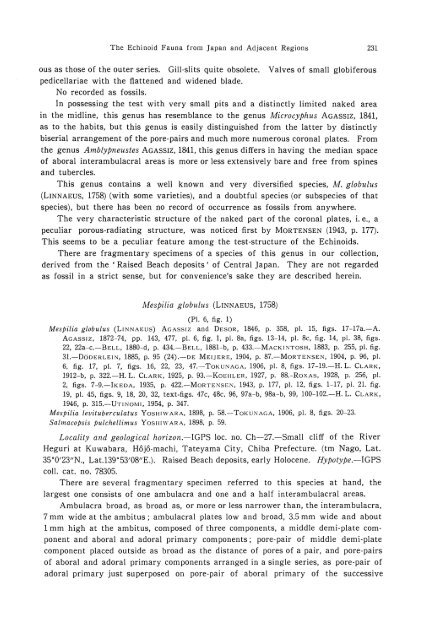the echinoid fauna from japan and adjacent regions part i
the echinoid fauna from japan and adjacent regions part i
the echinoid fauna from japan and adjacent regions part i
Create successful ePaper yourself
Turn your PDF publications into a flip-book with our unique Google optimized e-Paper software.
The Echinoid Fauna <strong>from</strong> Japan <strong>and</strong> Adjacent Regions 231<br />
ous as those of <strong>the</strong> outer series. Gill-slits quite obsolete. Valves of small globiferous<br />
pedicellariae with <strong>the</strong> flattened <strong>and</strong> widened blade.<br />
No recorded as fossils.<br />
In possessing <strong>the</strong> test with very small pits <strong>and</strong> a distinctly limited naked area<br />
in <strong>the</strong> midline, this genus has resemblance to <strong>the</strong> genus Microcyphus AGASSIZ, 1841,<br />
as to <strong>the</strong> habits, but this genus is easily distinguished <strong>from</strong> <strong>the</strong> latter by distinctly<br />
biserial arrangement of <strong>the</strong> pore-pairs <strong>and</strong> much more numerous coronal plates. From<br />
<strong>the</strong> genus Amblypneustes AGASSIZ, 1841, this genus differs in having <strong>the</strong> median space<br />
of aboral interambulacral areas is more or less extensively bare <strong>and</strong> free <strong>from</strong> spines<br />
<strong>and</strong> tubercles.<br />
This genus contains a well known <strong>and</strong> very diversified species, M. globulus<br />
(LINNAEUS, 1758) (with some varieties), <strong>and</strong> a doubtful species (or subspecies of that<br />
species), but <strong>the</strong>re has been no record of occurrence as fossils <strong>from</strong> anywhere.<br />
The very characteristic structure of <strong>the</strong> naked <strong>part</strong> of <strong>the</strong> coronal plates, i. e., a<br />
peculiar porous-radiating structure, was noticed first by MORTENSEN (1943, p. 177).<br />
This seems to be a peculiar feature among <strong>the</strong> test-structure of <strong>the</strong> Echinoids.<br />
There are fragmentary specimens of a species of this genus in our collection,<br />
derived <strong>from</strong> <strong>the</strong>' Raised Beach deposits' of Central Japan. They are not regarded<br />
as fossil in a strict sense, but for convenience's sake <strong>the</strong>y are described herein.<br />
Mespilia globulus (LINNAEUS, 1758)<br />
(PI. 6, fig. 1)<br />
Mespilia globulus (LINNAEUS) AGASSIZ <strong>and</strong> DESOR, 1846, p. 358, pI. 15, figs. 17-17a.-A.<br />
AGASSIZ, 1872-74, pp. 143, 477, pI. 6, fig. I, pI. 8a, figs. 13-14, pI. 8c, fig. 14, pI. 38, figs.<br />
22, 22a-c.-BELL, 1880-d, p. 434.-BELL, 1881-b, p. 433.-MACKINTOSH, 1883, p. 255, pI. fig.<br />
31.-DoDERLEI"i, 1885, p. 95 (24).-DE MEIJERE, 1904, p. 87.-MoRTEl\:SEN, 1904, p. 96, pI.<br />
6, fig. 17, pI. 7, figs. 16, 22, 23, 47.-ToKUNAGA, 1906, pI. 8, figs. 17-19.-H. L. CLARK,<br />
1912-b, p. 322.-H. L. CLARK, 1925, p. 93.-KoEHLER, 1927, p. 88.-RoxAs, 1928, p. 256, pI.<br />
2, figs. 7-9.-IKEDA, 1935, p. 422.-MoRTENSEN, 1943, p. 177, pI. 12, figs. 1-17, pI. 21. fig.<br />
19, pI. 45, figs. 9, 18, 20, 32, text-figs. 47c, 48c. 96, 97a-b, 98a-b, 99, 100-102.-H. L. CLARK,<br />
1946, p. 315.-UTINOMI, 1954, p. 347.<br />
M espilia levituberculatus Y OSIllW ARA, 1898, p. 58.-TOK UN AGA, 1906, pI. 8, figs. 20-23.<br />
Salmacopsis pulchellimus YOSIIl\\' ARA, 1898. p. 59.<br />
Locality <strong>and</strong> geological horizon.-IGPS loco no. Ch-27.-Small cliff of <strong>the</strong> River<br />
Heguri at Kuwabara, H6j6-machi, Tateyama City, Chiba Prefecture. (tm Nago, Lat.<br />
35°0'23"N., Lat.l39°53'08"E.). Raised Beach deposits, early Holocene. Hypotype.-IGPS<br />
colI. cat. no. 78305.<br />
There are several fragmentary specimen referred to this species at h<strong>and</strong>, <strong>the</strong><br />
largest one consists of one ambulacra <strong>and</strong> one <strong>and</strong> a half interambulacral areas.<br />
Ambulacra broad, as broad as, or more or less narrower than, <strong>the</strong> interambulacra,<br />
7 mm wide at <strong>the</strong> ambitus; ambulacral plates low <strong>and</strong> broad, 3.5 mm wide <strong>and</strong> about<br />
1 mm high at <strong>the</strong> ambitus, composed of three components, a middle demi-plate component<br />
<strong>and</strong> aboral <strong>and</strong> adoral primary components; pore-pair of middle demi-plate<br />
component placed outside as broad as <strong>the</strong> distance of pores of a pair, <strong>and</strong> pore-pairs<br />
of aboral <strong>and</strong> adoral primary components arranged in a single series, as pore-pair of<br />
adoral primary just superposed on pore-pair of aboral primary of <strong>the</strong> successive












